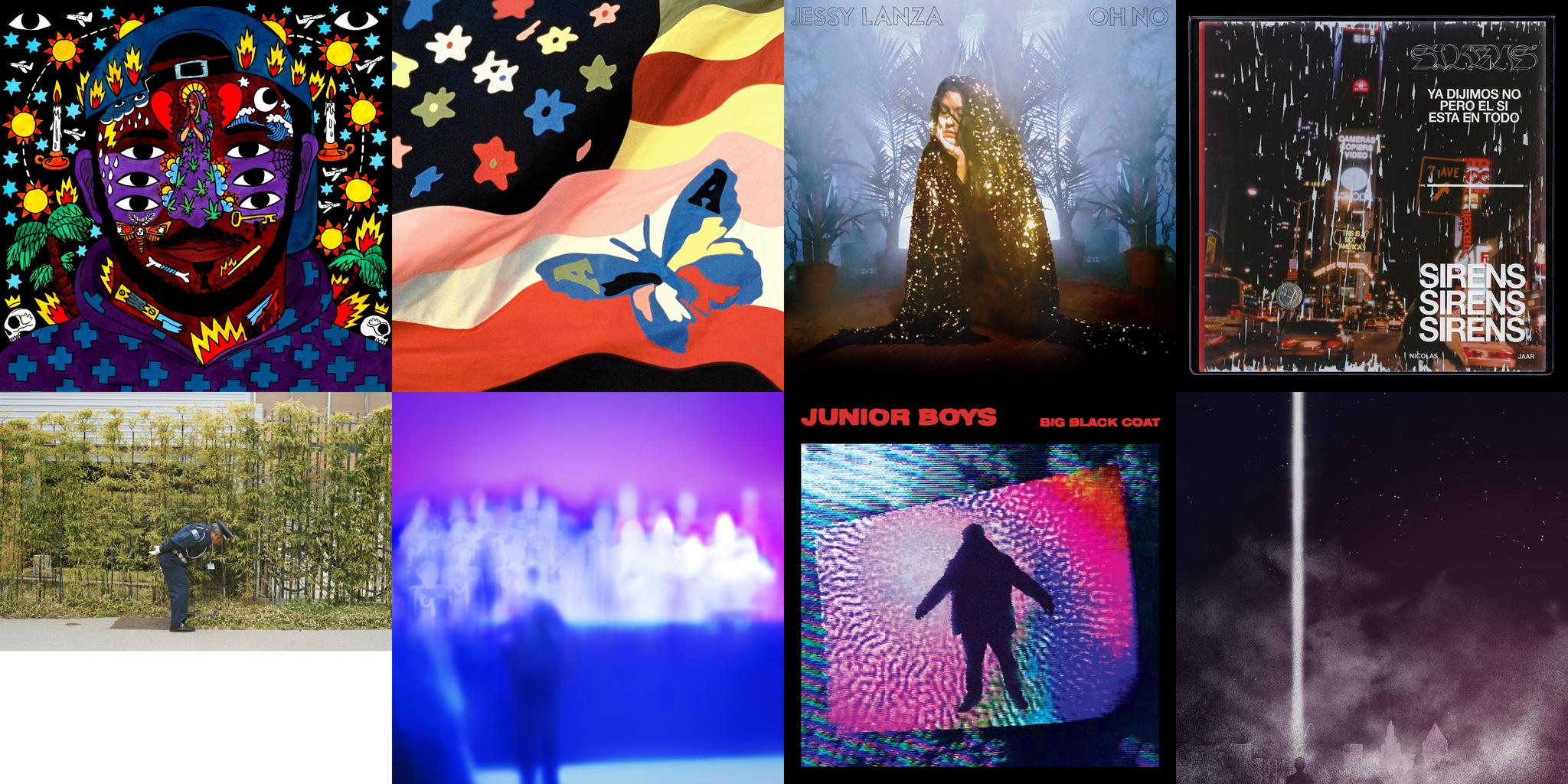
Exclaim!'s Top 10 Dance & Electronic Albums of 2016
Our Best of 2016 albums lists by genre continue today with our staff picks for the 10 best electronic albums this year.
Click next to re...
Published: December 07, 2016 13:00
Source

KAYTRANADA\'s debut LP is a guest-packed club night of vintage house, hip-hop, and soul. The Montreal producer brings a rich old-school feel to all of these tracks, but it’s his vocalists that put them over the edge. AlunaGeorge drops a sizzling topline over a swervy beat on “TOGETHER,” Syd brings bedroom vibes to the bassline-driven house tune “YOU’RE THE ONE,” and Anderson .Paak is mysterious and laidback on the hazy soundscape “GLOWED UP.” And when Karriem Riggins and River Tiber assist on the boom-bap atmospheres of “BUS RIDE,\" they simply cement the deal.

The Australian group finally returns with its long-rumored follow-up to *Since I Left You*, the 2000 album that earned them a ravenous following. *Wildflower* is a continuous mix of the wild and weird, another hallucinogenic collage of samples ranging from R&B to orchestral pop. From the calypso-klezmer \"Frankie Sinatra,\" featuring Danny Brown, to Biz Markie chomping over a Beatles sample on \"Noisy Eater,” it’s the tour de force soundtrack to music\'s past and present.

Jessy Lanza's second album 'Oh No' is inspired by Japanese 80s electro outfit Yellow Magic Orchestra’s philosophy of experimental pop. Playfully laced with cascading arpeggios, crispy drum machines and breezy songs, 'Oh No' has an infectious energy that has carried over from her live shows. Made in her hometown of Hamilton, Ontario, with production partner Jeremy Greenspan from Junior Boys, the plaintive, reverb drizzled mood of the first album has all but given away to a more direct, confident and joyful album. As Jessy says ‘I want to make people feel good and I want to make myself feel good’.

The first sound on Nicolas Jaar’s new record Sirens is a flag whipping in a gale. It’s the sort of sound you don’t realize you know until you hear it. But it’s unmistakable. And pregnant with meaning: nation, memory, conquest—but also frailty, a delicate thing buffeted by mercurial winds. The second sound is breaking glass. Nicholas Jaar has been busy. Since 2015, he’s released Nymphs, a series of four EPs, and Pomegranates, an alternate soundtrack to Sergei Parajanov's 1969 film The Colour of Pomegranates. If Nymphs and Pomegranates represent two sides of the coin of Jaar’s work—club and experimental ambient respectively—Sirens, he says, is“the coin itself”: the terrain, the constraints, the material conditions from which the others emerge. Sirens is animated by an ambivalence at the heart of American music: that, in some fundamental sense, the history of American popular culture is a history of theft. The six lush tracks move seamlessly from rock to reggaetón to doo-wop, each exhibiting Jaar’s signature sensitivity to restraint and exuberance, disjuncture and groove, comfort and disquiet. Foregrounded throughout is the question of what these forms—artifacts of empire and its resistance both—can do for us today. Jaar, whose parents lived under dictatorship in Chile and whose grandparents are Palestinian, ascribes to Víctor Jara’s philosophy that you’re making political music whether you want to or not. The injustices of the past weigh heavily on the living, structuring the possibilities of the present. As Jaar sings, “we’re all waiting for the old thoughts to die.” For now, they’re our thoughts too. Jaar composed and recorded all the music on Sirens himself, with one exception: a sample of the Andean folk song “Lagrimas”—tears—which appears, almost unadorned, in the middle of “No,” the fourth track on Siren. “No” recalls the Chilean national plebiscite of 1988, when artists and activists organized millions of Chileans to vote “no”to the dictatorship of Augusto Pinochet. The song is a meditation on the seeming futility of protest against systems that structure our very reality. Over a loping reggaetón beat, Jaar laments, “ya dijimos no, pero el Si está en todo.”We already said no, but the Yes is everywhere. The songs on Sirens are fiercely critical, but they are generous too, even loving. “I made these songs to play for my friends, for people going to see music,” Jaar says. The place he wants to be is liminal: between the precious sense of freedom that only music can provide, and the reality that there’s no escape; between “knowing that we’re trying to get away and knowing that we can’t. That maybe,” he says, “we shouldn’t.” After the glass shatters, a rush of sound, fluttering pianos and synth mingle with the shards. The shimmering music billows and quiets. There is calm. Then the glass shatters again.




The Range is a digital archaeologist, unearthing deep musical emotion from the obscure sounds he digs up on YouTube. For *Potential*, the Brooklyn producer searched for voices in particular, incorporating them into his alternately lush and dank masses of beats and bass. Anonymous singsong flits ethereally through “Florida,” which skips and struts over thick kicks accessorized with clipped steel-drum ping and banjo pluck. Others, like “1804,” revolve around rapping or toasting by unknown MCs whose words cut a path through nostalgic yet novel combinations of jungle, dubstep, grime, and ambient music.

On his fourth album, Tycho’s Scott Hansen continues to fold shimmering electronics into shoegaze to majestic effect. Drummer Rory O’Connor brings a supple rhythmic backbone to “Glider” and “Slack,” while Zac Brown’s guitars and electric bass add depth and definition to expansive atmospheres, particularly on the yearning, New Wave–flavored “Horizon.” On the forceful “Epoch,” Brown’s guitars pair ringing fretwork with pulsing arpeggios and muscular grooves. “Field” closes the album in a wash of clean-toned strumming, sounding as hopeful as the horizon is wide.
An epoch is defined as an extended period of time typically characterized by a distinctive development or by a memorable series of events, and Scott Hansen, leader of the band Tycho, has named their new album Epoch with that in mind. The last installment in a trilogy, Epoch is the culmination of more than a decade’s work that has seen the band evolving and maturing through two sublime releases Dive (2011) and Awake (2014), and developing from featuring Hansen as a delicate solo performer into the iconic frontman of a powerful multi-layered live band performing on the world’s largest stages. “Dive was where the whole thing crystallized,” said Hansen. “I found that crossover space between what I was doing before, which was more IDM electronic stuff, and the rock music that reflected more of what I was listening to and not necessarily what I was making. Awake was a prototype of pushing it as far into the rock realm as I was comfortable with. Epoch is basically coming full circle. All the lessons of Dive and Awake were applied and then expanded upon. Epoch leverages the sonic aesthetic of Dive’s down-tempo vintage-style synthesizers and beautiful melodies while drawing on the kinetic energy of Awake’s progressive composition and organic instrumentation. “I felt like I explored a lot of open-ended unbridled, optimistic spaces with the other records. I don't know if it's a reflection of my life, but it seemed like that’s what just came out at the time.” For the new record, the themes felt a bit darker as he explored new musical territory. “My threshold for darkness is much lower. Things that seem dark to me seem happy and light to other people. I think it’s the darker sounds themselves. The timbres are a bit more aggressive.” Hansen initially attempted a more traditional recording process at Panoramic Studios in Stinson Beach, CA, but ultimately opted to do the majority of the recording in his home studio in Berkeley following a temporary relocation from his home in San Francisco. “I’ve been in the same San Francisco house the last 11 years. I made the last two records in the exact same room. I figured it was time for a change. There were a few other factors as well. I wanted to get some more space, be relaxed, and not be living in the middle of a crazy city. I wanted to have a more relaxed environment where noise or people didn’t bother me. Mostly just for the isolation.” Once complete, it was important to Hansen to release Epoch as a surprise album. “I've never been fond of handing in an album then waiting 4 months for it to be released,” he said. “I wanted to be more connected to the people consuming the music. There is a kind of visceral fulfillment you get from sharing something that you've just created with other people. That's a very satisfying feeling as an artist. “All art is in some way shaped by the current state of the world around the person creating it so there's a element of zeitgeist built into any album. We just finished mastering the album so it will be a month old when people hear it. I'm hoping people get a sense that this music is directly connected to the time they are experiencing it in.” Epoch was arranged alongside Zac Brown, a long time collaborator and partner in the Tycho project. Brown contributed bass and guitar parts to the songwriting process, while Rory O'Connor played drums. O’Connor was brought in during the Dive tour cycle. Hansen has known Brown since their Sacramento upbringing. “At the end of Dive is when we started to work together on a couple songs. I thought there should be more guitar. Zac played on a couple songs like on ‘Ascension.’ He played some bass and guitar on ‘Hours.’ I brought him on to play parts in the shows. We did Awake together. We took the same approach with this record.” Hansen sees Epoch as a multi-dimensional artistic vision at the confluence of his graphic design work via ISO50 and music with Tycho. The graphic presentation of the album artwork is as important as the music itself. The keystone is the central image of Epoch and the colour scheme red and black. This is a stark contrast to the almost rainbow palette of Awake.